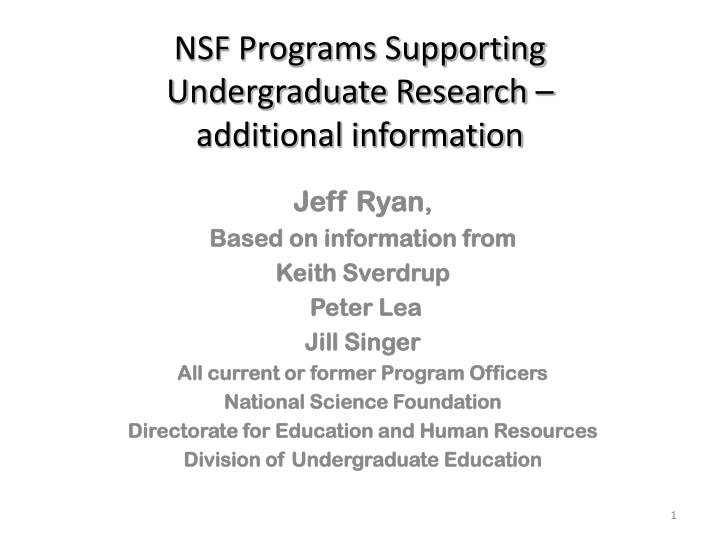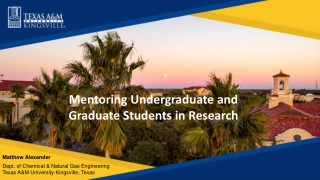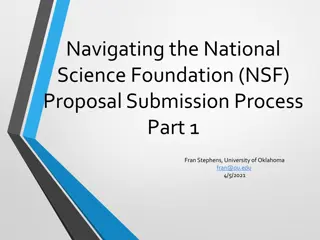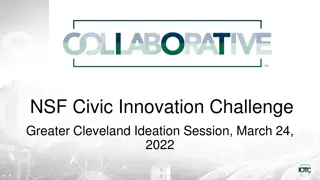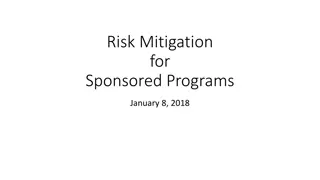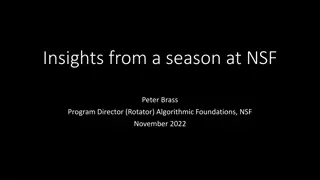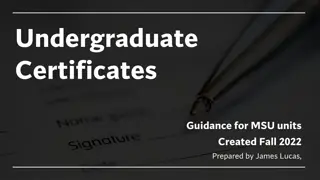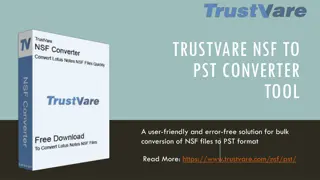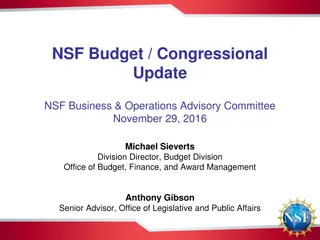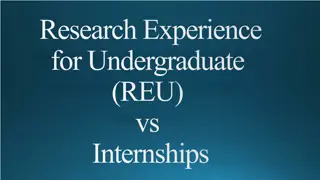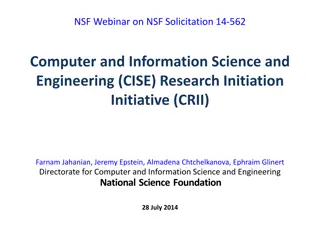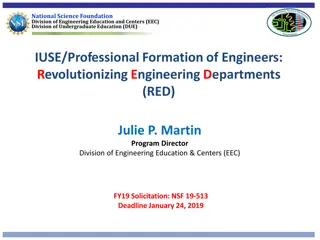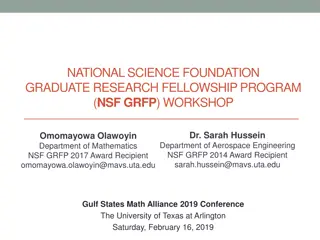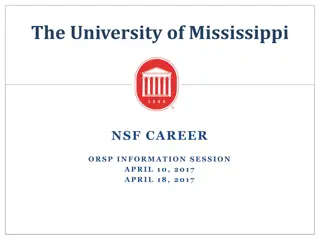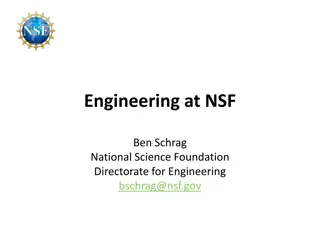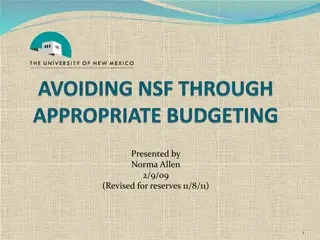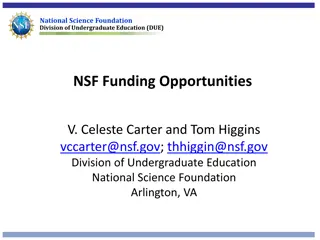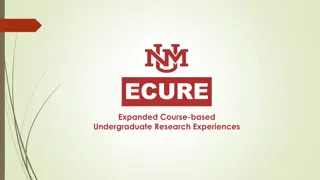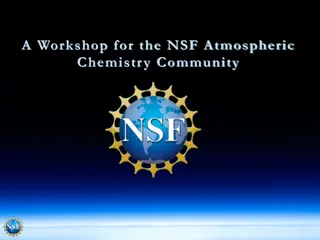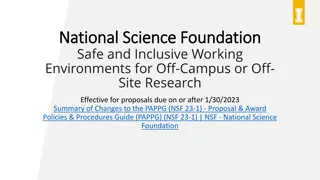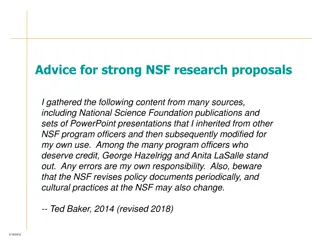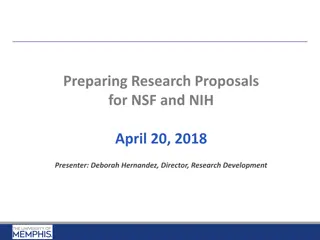NSF Programs Supporting Undergraduate Research Overview
Explore various NSF programs supporting undergraduate research and education, including opportunities such as Research in Undergraduate Institutions (RUI) and Research Opportunity Awards (ROA) aimed at leveling the playing field and fostering future generations of researchers. Learn how these initiatives align with national STEM student recruitment goals and NSF objectives, and the potential for collaboration with Program Officers.
Download Presentation

Please find below an Image/Link to download the presentation.
The content on the website is provided AS IS for your information and personal use only. It may not be sold, licensed, or shared on other websites without obtaining consent from the author.If you encounter any issues during the download, it is possible that the publisher has removed the file from their server.
You are allowed to download the files provided on this website for personal or commercial use, subject to the condition that they are used lawfully. All files are the property of their respective owners.
The content on the website is provided AS IS for your information and personal use only. It may not be sold, licensed, or shared on other websites without obtaining consent from the author.
E N D
Presentation Transcript
NSF Programs Supporting Undergraduate Research additional information Jeff Ryan Jeff Ryan, , Based on information from Based on information from Keith Sverdrup Keith Sverdrup Peter Lea Peter Lea Jill Singer Jill Singer All current or former Program Officers All current or former Program Officers National Science Foundation National Science Foundation Directorate for Education and Human Resources Directorate for Education and Human Resources Division of Undergraduate Education Division of Undergraduate Education 1
Unpacking the Silos (TMI? OMG! YMMV.) Directorate Geosciences (GEO) Divisions Earth Sciences Ocean Sciences Atmospheric & Geospace Sciences Polar Programs Undergraduate Education (DUE) Graduate Education (DGE) Research on Learning (DRL) Human Resource Development (HRD) Education & Human Resources (EHR) Cross- Directorate programs Research Experiences for Undergraduates (REU) Research at Undergraduate Institutions (RUI) Innovations in Undergraduate STEM Education (IUSE) 2
NSF Opportunities to support Undergraduate Research and Education A lot of these opportunities are Foundation-wide initiatives Arises from national concerns re: improving recruitment and retention of STEM students (PCAST) Arises from NSF prerogative toward broadening the PI base (new institutions and new performers) Many Foundation-wide programs are interpreted in the context of Directorate/Division/Program objectives Talk to your program officer about this fit ! 3
Research in Undergraduate Institutions (RUI) Research Opportunity Awards (ROA) Big idea is to level the playing field between UG and research universities, and to recognize role of UG institutions in research and developing the future generations of researchers A RUI proposal may be Request to support individual or collaborative research project involving PUI faculty and students at their own or other institutions Request involving shared research facilities ROA proposals may be A supplement to an existing NSF award to support activities for PUI faculty Requests to rebudget funds in an existing NSF award to support activities for PUI faculty New collaborative proposal with ROA as a component or subaward 4
Research Experiences for Undergraduates (REU) NSF s ambtion is to encourage researchers (esp. graduate-focused) to involve undergraduates (UGs) Supports active research participation by undergraduate students in any of the areas of research funded by NSF REU Supplements to regular research awards (those from primarily UG institutions tend to involve UGs up front) REU Sites bring in undergraduates mainly from other institutions to participate in research around a coherent theme 5
Research Experiences for Undergraduates (REU) REU describes a full undergraduate research experience that student activities should model (i.e., initiation/development, conduct, interpret and present/publish investigation) Cohort-building and professional development for students are part of the experience. REU funding is structured re: student experiences (stipend rate, etc.) which limits support in Supplements and Sites One can build REU-structured funds into regular NSF grant requests, however! 6
Major Research Instrumentation (MRI) Program objective is to increase access to instruments for research and research training <$100K to $4M, with 30% institutional cost share for Ph.D.- granting institutions (tip: can negotiate as part of start-up package); 3 MRIs per institution per year encourages shared use within and between organizations, including private-sector partners BIG emphasis here on PUI s (Predominantly Undergraduate Institutions) no cost share required, projects can be UG- focused research effort as opposed to simply acquiring hardware for research 7
All proposals undergo merit review Program director arranges reviews through individual mail (ad hoc) reviews or panels Reviewers provide their opinions on intellectual merit and broader impacts based on criteria in GPG and solicitation Program Director decides: Recommends decline or award (typically following negotiation), concurred by Division Director Either way, PI gets verbatim reviews, panel summary (if applicable) and program-director comments
Review and Submission NSF merit criteria for all proposals Intellectual Merit Broader Impacts Refer to program solicitation for explanations for program specific criteria of these Check spelling, grammar, margins, page limit, font size, etc. Use enough headings to help reviewers keep track of proposal sections.
Tips for Proposal Writing: preparing to write Start EARLY proposals take time to write, even longer for collaborative proposals Clarify your ideas and what you wan to do (or what you are willing to do) Find potential programs that support your ideas Red solicitations (program guidelines) CAREFULLY If your ideas don t fit, contact the Program officer to discuss your idea You may need to refine your idea or find another program
Tips for Proposal Writing: preparing to write Outline what you want to do Review the literature and descriptions of funded projects Know what is being done in your field and how your project is similar or different Give yourself and your grants officer enough time to complete the process and submit the proposal
Tips for Proposal Writing: preparing to write Let others know what about your plans Department colleagues/chair Does it fit within P&T guideliens? Department Chair/Dean especially if $ match Space/power requirements, technician time, repairs, service contract, etc. Some NSF programs limit the number of proposals submitted by an institution in any given round of a program (e.g. MRI)
Steps to Successful Proposal Writing Organize the proposal use the guidelines (program solicitation) Make it easy for reviewers to find key items Use subject headings, bullets, etc. Describe how you will evaluate the success of the project Be sure the budget and budget explanation match Be sure the budget reflects the size of the project Number of participants Instrumentation Etc.
Proposal Fatal Flaws Fatal Flaw #1 My ideas are so great, I m certain NSF won t care whether they fit in the program guideline. Read the solicitation carefully Write the proposal to address each area outlined in the solicitation Check each solicitation carefully (Additional Criteria, for example)
Proposal Fatal Flaws Fatal Flaw #2 Trust us, we know what we are doing. Formulate your idea(s), clearly state what you want to do Identify the audience(s) you want to work with Identify specific tasks and timeline for completion Give background information, cite the literature (demonstrate that you know what has been/is being done Address broader impacts (e.g. diversity)
Proposal Fatal Flaws Fatal Flaw #3 I an sure they don t actually count the pages. Maybe I should just use a smaller font. Follow the page and font-size limits Consult the program solicitation and the Grant Proposal Guide (GPG)
Proposal Fatal Flaws Fatal Flaw #4 NSF should know what I ve done in the past without my having to tell them. After all, they paid for it. Provide results from prior funding Include a dissemination plan in your current proposal
Proposal Fatal Flaws Fatal Flaw #5 Evaluation will be ongoing and consist of a variety of methods. Plan for formative and summative evaluation Include an evaluation plan with timelines and benchmarks
Proposal Fatal Flaws Fatal Flaw #6 I will inflate my budget because NSF always ends up cutting it anyways. Budget should directly reflect work plan Provide biographical sketches for key personnel
